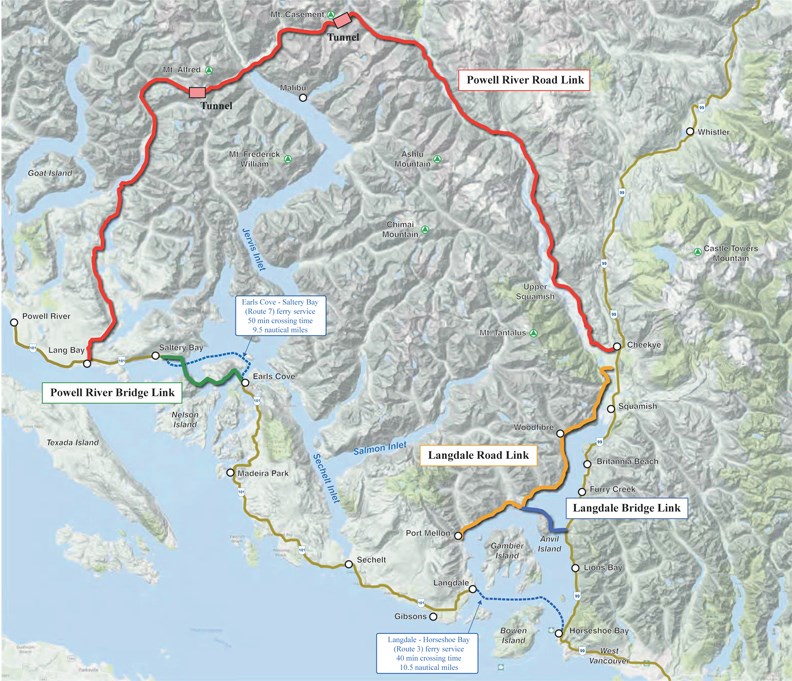The provincial government’s fixed link road show stopped on the Sunshine Coast this week.
The Ministry of Transportation and Infrastructure (MOTI) and consultants R. F. Binnie have been holding a series of open houses as part of a feasibility study on options to bypass the ferries and connect Powell River or the lower Sunshine Coast directly with the Sea to Sky corridor. The final open houses were in Sechelt on Wednesday and Gibsons on Thursday.
Binnie was awarded the $250,000 contract for the study earlier this year, and there has already been a series of invitation-only meetings with local government leaders, First Nations, Chambers of Commerce and others, as well as technical workshops.
The potential routes have been well known for months, but MOTI didn’t release many details until the public consultations kicked off last week.
Four options remain on the table.
There are two possibilities being considered to connect the lower Sunshine Coast and the Sea to Sky corridor: A pair of bridges across Howe Sound via Anvil Island (known as the Langdale Bridge Link) or a new highway along the west shore of Howe Sound between Port Mellon and Squamish (the Langdale Road Link).
The rough estimate for the maximum cost of the road is $2 billion, while the bridge is projected to cost as much as $2.5 billion.
In both scenarios, once the fixed link is completed, BC Ferries service between Langdale and Horseshoe Bay would be eliminated.
The choice being presented by MOTI is for either a Powell River or lower Sunshine Coast route. A fixed link over or around Howe Sound would mean Powell River continues to be served by ferries.
The road option between Powell River and Squamish ($3 billion) would involve keeping both the Earls Cove and Langdale ferry routes, but the bridge option via Nelson Island ($2 billion) would mean keeping the Langdale route only.
Powell River-Sunshine Coast MLA Nicholas Simons said although he wasn’t invited to this summer’s stakeholder meetings, he did attend one in Powell River. He also said he questions one of the statements being made in MOTI’s background material.
It says, “… various Sunshine Coast community leaders and stakeholders are increasingly advocating for a cost-effective fixed link connection to the Lower Mainland.”
“If the government interprets our complaints or our issues around ferry service and affordability as advocating for a fixed link – that’s fairly creative on their part,” Simons said. “What Sunshine Coast residents have been saying, increasingly – business leadership, political leadership, community leadership – we’ve all been saying we need better ferry service. Is a fixed link option, as far as it is away from being reality, the thing we should be focusing on for the immediate economic future of our communities?”
Ryan Medd, founder of the group Sunshine Coast Tolled Fixed Link, told Coast Reporter the cost of making those improvements to ferry service is one of the best cases to make in favour of a fixed link.
“Much of the cost of a fixed link is slated to be spent on our ferry route in the next decade,” he said. “Then we get to spend billions operating our route every 20 years after that. The fixed link eliminates the perpetual billion-dollar spend, and the subsequent inevitable increases in fares.”
Medd said from his perspective the Anvil Island bridge appears most practical.
“It has the shorter drive time to Metro Vancouver and it also allows for realistic transit links between BC Transit and Translink – an important consideration. Plus, given the right design, it could be a tourist attraction itself.”
Former Sunshine Coast Regional District economic development officer Oddvin Vedoe launched a blog in 2014 to push for a fixed link. In a recent post he wrote that he’s backing the bridge via Anvil Island.
“The provincial study will show that a fixed link is far better in the short and long run, compared with ferries that are costly to build, costly to operate, and not very reliable and not environmental friendly,” he wrote.
“If you look at Vancouver as a pressure cooker of waterfront and real estate, the Sunshine Coast with a fixed link is the safety valve. It will be a new reality. People can come and go whenever they want to. Business can locate and relocate here without depending on the ferries. Industry can compete, indeed benefit from establishing on the Coast. Tourism can reach goals they never dreamed of.”
As well as the cost estimates and technical information, MOTI’s backgrounders also include a basic evaluation of the impacts of the four options when compared to sticking with ferries. For example, travel times and reliability would be better, but safety would be worse and so would pedestrian/cyclist access. Both the bridge and the road would boost tourism and economic development, and increase population and residential property values, but put pressure on local infrastructure.
The ministry says the road would be neutral when it comes to “consistency with community policies, character and identity,” but the bridge would be worse.
Both options are also rated as worse, or much worse, when it comes to air quality and environmental effects.
Online comments are being accepted until Nov. 8 at gov.bc.ca/sunshinecoastfixedlink, which is also where you can view the background information.
R. F. Binnie is expected to deliver a final report by the end of the year, but it will ultimately be up to the provincial government to decide which, if any, of the fixed link options goes forward for more detailed studies.



